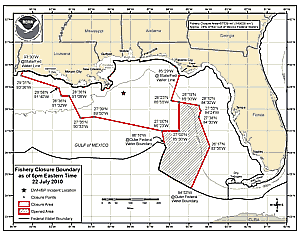
Reopened fishing area (in hashmarks) as of 6:00 p.m. (EDT) July 22, 2010. Closure area may be updated daily as necessary.
NOAA has reopened 26,388 square miles of Gulf waters to commercial and recreational fishing on Thursday at 6:00 pm EDT. The reopening of a third of the overall closed area was announced after consultation with FDA and under a re-opening protocol agreed to by NOAA, the FDA, and the Gulf states.
Since mid-June, NOAA data have shown no oil in the area, and United States Coast Guard observers flying over the area in the last 30 days have also not observed any oil. Additionally, trajectory models show the area is at a low risk for future exposure to oil, and fish caught in the area and tested by NOAA experts have shown no signs of contamination.
"Today's decision is good news for Gulf fishermen and American consumers," Commerce Secretary Gary Locke said. "Following the best science for this re-opening provides important assurance to the American people that the seafood they buy is safe and protects the Gulf seafood brand and the many people who depend on it for their livelihoods."
At its closest point, the area to be reopened is about 190 miles southeast of the Deepwater/BP wellhead, and the area where the majority of fishing will occur is about 220 miles from the wellhead, along the west Florida shelf.
"NOAA is working to protect public safety while minimizing harm to the fishing industry," said Jane Lubchenco, Ph.D., under secretary of commerce for oceans and atmosphere and NOAA administrator. "We are confident that seafood caught in this area is, and will continue to be, free from contamination."
Between June 23 and July 5, NOAA collected samples of fish, including grouper, snapper, tuna, and mahi mahi from the area where the heaviest fishing will take place. Sensory and chemical testing following the methodology and procedures in the re-opening protocol showed no detectable oil or dispersant odors or flavors, and the results of chemical analysis were well below the levels of concern.
"We are pleased today to be able to fully support the reopening of these waters," said Dr. Margaret A. Hamburg, commissioner of food and drugs. "We know it is important to get people back to fishing quickly -- this industry is the backbone of the Gulf region economy. At the same time, we need the American public to be confident in the seafood coming from the Gulf, and the testing that has been done as part of the agreed upon protocols has not indicated any level of concern."
NOAA will continue to take samples for testing from the newly re-opened area, and the agency has also implemented dockside sampling to test fish caught throughout the Gulf by commercial fishermen. Additionally, the NOAA research vessel Nancy Foster took water samples in and around the area proposed for re-opening during early to mid July. No surface sheens were observed and no unusual readings potentially indicative of oil were obtained during these activities.
At the time the area was originally closed, there was a concern that the light sheen observed in the northeastern portion of the area might enter the loop current and move quickly toward the Florida Keys. That fear, however, never materialized, and NOAA revisited its earlier assumptions, reaching the conclusion that these waters no longer need to be closed.
Fishery area closures remain the first line of defense to prevent contaminated seafood from entering the marketplace. NOAA continues to work closely with the U.S. Food and Drug Administration and the states to ensure seafood safety. NOAA and FDA are working together on broad-scale seafood sampling that includes sampling seafood from inside and outside the closure area, as well as dockside- and market-based sampling.
NOAA will continue to evaluate the need for fisheries closures based on the evolving nature of the spill and will re-open closed areas as appropriate.
